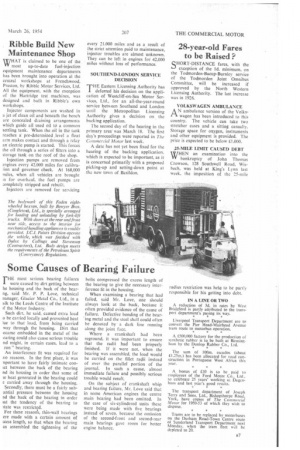Some Causes of Bearing Failure
Page 133

If you've noticed an error in this article please click here to report it so we can fix it.
THE most serious bearing failures were caused by dirt getting between he housing and the back of the bearng, said Mr. P. P. Love, technical nanager, Glacier Metal Co., Ltd., in a alk to the Leeds Centre of the Institute ,f the Motor Industry.
Such dirt, he said, caused extra load o be carried locally and prevented heat lue to that load, from being carried way through the housing. Dirt that eca.rne embedded in the metal of the ,earing could also cause serious trouble nd might, in certain cases, lead to a run" bearing.
An interference lit was required for NO reasons. In the first place, it was nportant to have fairly intimate conLet between the back of the bearing nd its housing in order that some of se heat generated in the bearing could c carried away through the housing. Secondly, there must be a fairly subantial pressure between the housing ad the back of the beating in order tat the tendency of the bearing to ttate was restrictid.
For these reasons, thin-wall bearings ere made with a certain amount of tcess length, so that when the bearing as assembled the tightening of the
bolts compressed the excess length of the bearing to give the necessary interference tit in the housing.
When examining a bearing that had failed, said Mr. Love, one should always look at the back, because it often provided evidence of the cause of failure. Defective bonding of the bearing metal and the steel shell could often be denoted by a dark line running along the joint face.
Where a crankshaft had been reground, it was important to ensure that the radii had been properly finished. If it were not, when the bearing was assembled, the load would be carried on the fillet radii instead of over the parallel portion of the journal. In such a cause, almost immediate failure and possibly serious trouble would result.
On the subject of crankshaft whip and bearing failure, Mr. Love said that in some American engines the centre main bearing had been omitted. In the case of six-cylindered units these were being made with five bearings instead of seven, because the omission of the second-front and second-rear main bearings gave room for better engine balance.
































































































































































































